| On this page |
|
| Since | 20.0 |
概要 ¶
このノードは、Skyフィールドボリューム内にノイズパターンを生成します。
これは、
Sky Field Noiseノードに似ていますが、このノードは、さらに雲特有のパラメータとプリセットを備えたハイレベルノードです。
例えば、シーン内に積雲パターンを追加することができます。
Sky Field Patternノードを使用して雲パターンを追加する方法は、How to 大空を作成するを参照してください。

内部的には、このノードは、Volume Noise Fog SOPを使用して、
Cloud Noise VOP、
Undulatus VOP、
Fibratus VOP、
Floccus VOP、
Fractus VOPで生成されたノイズを適用しています。
このノードは、雲の厚みを無視します。
パラメータ ¶
Layers ¶
Pattern Layer
ノイズを適用するボリュームの名前。
デフォルト値はskyです。
Mask Layer
マスクボリュームをこのノードの2番目の入力に接続した場合、ここには、このノードの効果をマスクするのに使用されるその2番目の入力内のボリュームを指定します(通常はmask)。
Add a Mask Paint ボタンをクリックすると、ビューポート内でそのマスクをペイントすることができ、自動的にPaintノードが2番目の入力に接続されます。
デフォルト値はskymaskです。
Blend
マスクボリュームをこのノードの2番目の入力に接続した場合、これは、Pattern LayerとMask Layerをブレンドします。
これが0の場合、このノードは何もせず、単にPattern Layerを通過させます。
これが1の場合、このノードはPattern LayerをMask Layerに置換します。
デフォルト値は1です。
General ¶
Operation
生成された Adjust Value の値と入力のボリューム値を合成させる方法を指定します。 ターゲットプリミティブが入力ジオメトリ上に存在しなかった場合、どのオペレーションも同じ効果になります。
Set
生成された Adjust Value で既存のボリュームプリミティブ値を上書きしたい場合には、このオペレーションを使用します。
Add
生成された Adjust Value が既存のボリュームプリミティブ値に加算されます。
Subtract
生成された Adjust Value が既存のボリュームプリミティブ値から減算されます。
Multiply
生成された Adjust Value が既存のボリュームプリミティブ値に乗算されます。
Minimum
既存のボリュームプリミティブ値と生成された Adjust Value の小さい方の値が出力されます。
Maximum
既存のボリュームプリミティブ値と生成された Adjust Value の大きい方の値が出力されます。
Sky Pattern
生成するノイズのタイプを指定します。 アルゴリズムが異なるので、異なる特性のノイズが生成されます。
Cumulus
Cumulus(積雲)
パターンを生成します。

Fractus
ぼろぼろと崩れた形の雲片(
Fractus(断片雲)
)パターンを生成します。

Floccus
羊毛の房に似た
Floccus(房状雲)
パターンを生成します。

Fibratus
細いすじ状の
Fibratus(毛状雲)
パターンを生成します。

Undulatus
波模様の
Undulatus(波状雲)
パターンを生成します。

Rotation
Skyフィールドの法線ベクトルを使用してパターンを回転させます。
Cumulus ¶
Cumulus Pattern ¶
Noise Type
生成するノイズのタイプ。 アルゴリズムが異なれば、ノイズの特性も異なります。
Alligator
ワニの皮のような凸凹のある出力を生成します。 このノイズはフラクタル反復によって歪むことはないですが、より細かな凸凹のある雲のディテールを作成するのに役立ちます。

Perlin
Simplex
Perlinと同様のノイズですが、このノイズラティスは、グリッド上ではなく四面体メッシュ上にあります。 これによって、Perlinノイズでよく見受けられるグリッド状のパターンを回避することができます。
Distortion を-1(左)と+1(右)に設定したSimplexノイズ:


Fast Simplex
このSimplex系ノイズ関数は、異なるラティス構造と処理が軽い累積メソッドを使用します。
Distortion を-1(左)と+1(右)に設定したSimplexノイズ:
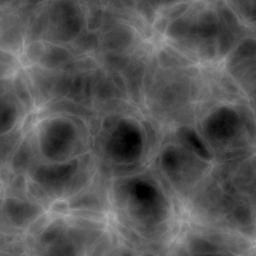

Element Size
ノイズ内のエレメントの均一スケール。
Per Componentボタンを有効にすると、軸別に Element Size をスケールすることができます。
Element Scale
Per Componentボタンを有効にすると、軸別に Element Scale をスケールすることができます。
Offset
評価されたノイズフィールドのオフセット量(各軸に追加されます)。 全体的に求めているノイズ効果が得られているものの、異なるルックを得るために異なる値を設定したい場合は、このオフセットを変更してみてください。
ここで$T * 0.25などのエクスプレッションを使用することでノイズをアニメーションさせることができます。
これは、 Animate Noise よりも計算が速いですが、ノイズフィールド全体が視覚的に“パン”したような効果になります。
Per Componentボタンを有効にすると、軸別にオフセットを追加することができます。
Offset
Per Componentボタンを有効にすると、軸別にオフセットを追加することができます。
Worley Details ¶
Add Worley Details
有効にすると、Worleyノイズが( Noise Type で指定された)ノイズパターンと結合されて、ふわふわした雲のノイズが得られます。 これを有効にすると、( Distortion で指定された)歪み効果が大幅に減少します。
Worleyノイズが追加されたノイズパターン:

Blend
( Noise Type で指定された)ノイズパターンとWorleyノイズを混ぜる量を制御します。
0の値は、ノイズパターンにWorleyノイズが適用されないことを意味します。
Erosion
ノイズパターンのエッジが0になる速さを制御します。 値が大きいほど、より多くのエッジが侵食されて、だんだん小さい雲パッチが生成されます。
Element Size Scale
Worleyノイズパターンに影響を与える Element Size パラメータの乗数。
Value Correction ¶
Bias
この値は、中間グレー(0.5周辺のノイズ値)を0に寄せる( Bias が1未満の場合)、または、1に寄せる( Bias が1より大きい場合)度合いを制御します。
0.5の値は、ノイズ値をそのままにします。

Gain
0と1周辺のノイズ値を引き離しつつ、中間グレー(0.5周辺のノイズ値)を引き寄せる度合いを制御します。
0.5の値は、ノイズ値をそのままにします。

Gamma
生成されたノイズ全体のガンマを制御します。
1未満の値は、ノイズを暗くし、元々明るい領域の値の範囲が広がります。
逆に、1より大きい値は、元々暗い領域の値の範囲が広がり、ノイズ全体の明るさが増します。
Contrast
この値は、全体のトーン値の範囲を拡大または縮小させます。
特に、各ノイズ値は中間グレー(0.5のノイズ値)に寄ったり( Contrast が1未満の場合)、中間グレーから離れます( Contrast が1より大きい場合 )。
Fractal ¶
Max Octaves
基本ノイズの出力に追加するゆがみの繰り返し回数です。 追加する繰り返しが多くなると、よりきめ細かい出力になります。 なお、出力では、このパラメータよりオクターブが少なくなることがあります(つまりパラメータを大きくすると、最終的にはディテールの追加が停止する)。 これは、出力にディテールを追加するスペースがなくなった時に、ノードは最終的に停止するからです。
Lacunarity
基本出力に追加されるフラクタルノイズの繰り返し間での振動数の増分です。なお、マイナス値を使用することができます。
Roughness
基本出力に追加されるフラクタルノイズの繰り返し間でのスケールの増分です。 値を大きくすると、出力に追加される“ジャギー”が大きくなります。Roughnessにはマイナス値を使用することができます。
Warping ¶
Distortion
Distortion が1より大きい場合はノイズ値が減少する方向で、 Distortion が1未満の場合はノイズ値が増加する方向で、ノイズが歪められる量を制御します。
Worleyノイズのディテールがノイズパターンに追加されると、この歪み効果は大幅に減少します。
Distortionの値が1:
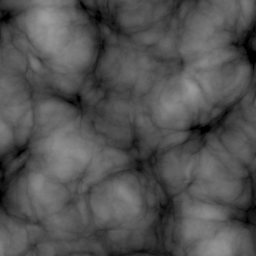
Distortionの値が-1:

Stretch
各方向にノイズを伸ばす量。 Element Size の代わりにこれを使用するメリットは、一部のディテールは引き伸ばされずにそのまま維持され、引き伸ばされたノイズパターンはより自然な感じに見えることです。
X軸方向で Element Scale が3(左)と Stretch が3(右)の比較:


Droop
ノイズパターンが指定したDroop方向に曲がったり垂れ下がったりするように、生成されたノイズを歪めます。
Noise pattern without (left) and with droop applied (right):
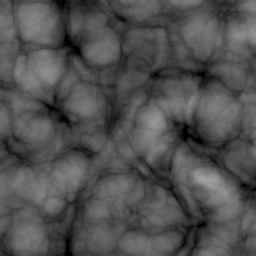

Droop Direction
ノイズが歪められる方向。
Fold
値を-1から1の間にリマップし、0未満の値をプラスの範囲に反転させるので、すべての谷が山になります。

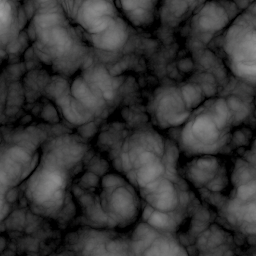
Fractus ¶
Fractus Pattern ¶
Element Size
ノイズ内のエレメントの均一スケール。
Per Componentボタンを有効にすると、軸別に Element Size をスケールすることができます。
Element Scale
Per Componentボタンを有効にすると、軸別に Element Scale をスケールすることができます。
Offset
評価されたノイズフィールドのオフセット量(各軸に追加されます)。 全体的に求めているノイズ効果が得られているものの、異なるルックを得るために異なる値を設定したい場合は、このオフセットを変更してみてください。
ここで$T * 0.25などのエクスプレッションを使用することでノイズをアニメーションさせることができます。
これは、 Animate Noise よりも計算が速いですが、ノイズフィールド全体が視覚的に“パン”したような効果になるので好みが分かれます。
Per Componentボタンを有効にすると、軸別にオフセットを追加することができます。
Offset
Per Componentボタンを有効にすると、軸別にオフセットを追加することができます。
Wispy Details ¶
Noise Type
生成するノイズタイプです。アルゴリズムを変更すると異なる特性のノイズが生成されます。
Fast
デフォルト。より高速でもっと面白いPerlinノイズのバリエーションです。
周波数は1.25倍でスケールされます。

Sparse Convolution
Sparse Convolutionノイズは、Worleyノイズに似ています。グリッドポイントでの乱れはありません。
周波数は1.25倍でスケールされます。

Alligator
でこぼこの多い出力を作成します。ワニ革に似ているということで、この名前になりました。
周波数は1.64倍でスケールされます。
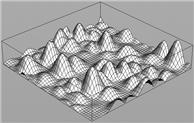
Perlin
視覚的ディテールが同じサイズのノイズです。 Wikipedia を参照してください。


Perlin Flow
回転するPerlinノイズのように時間が経過しても安定したノイズ。これは、時間の経過とともに滑らかに渦巻いて流れるようなノイズを作成するのに役立ちます。 以下の Flow Rotation パラメータを使用して回転を制御します。
Simplex
Perlinノイズに似たノイズですが、そのノイズラティスはグリッドではなく四面体メッシュ上に乗っています。 これによって、Perlinノイズでよく見受けられるグリッドパターンを回避することができます。
Worley Cellular F1
植物の細胞や海の波、ハチの巣、クレーターのある景色などに似た細胞特性を作成します。 Wikipedia を参照してください。
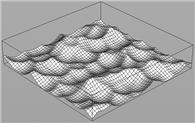
Worley Cellular F2-F1
Worleyノイズのバリエーションで、鈍化させたり、角を付けたりする特性を作成します。

Manhattan Cellular F1
マンハッタン距離の計算法を使用したWorley F1ノイズのバリエーション。独特なルックのノイズが必要な時に役立ちます。
Manhattan Cellular F2-F1
マンハッタン距離の計算法を使用したWorley F2-F1ノイズのバリエーション。独特なルックのノイズが必要な時に役立ちます。
Chebyshev Cellular F1
チェビシェフ距離の計算法を使用したWorley F1ノイズのバリエーション。独特なルックのノイズが必要な時に役立ちます。
Chebyshev Cellular F2-F1
チェビシェフ距離の計算法を使用したWorley F2-F1ノイズのバリエーション。独特なルックのノイズが必要な時に役立ちます。
Wispy Strength
かすれたノイズの歪み量を制御します。
Billowy Details ¶
Billowy Details
大きなかすれた雲のディテールをもっともくもくしたパターンに変えます。
Billowy Details が無効(左)、有効(右)なFractusノイズ:

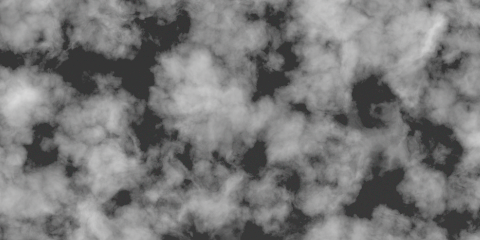
Billowy Strength
パターン内のもくもくしたノイズの量を制御します。 このパラメータと Wispy Strength コントロールを組み合わせて使用することで、もっと面白い混合パターンを生成することができます。
Worley Details ¶
Add Worley Details
有効にすると、Worleyノイズが( Noise Type で指定された)ノイズパターンと結合されて、ふわふわした雲のノイズが得られます。 これを有効にすると、( Distortion で指定された)歪み効果が大幅に減少します。
Worleyノイズが追加されたノイズパターン:

Blend
( Noise Type で指定された)ノイズパターンとWorleyノイズを混ぜる量を制御します。
0の値は、ノイズパターンにWorleyノイズが適用されないことを意味します。
Erosion
ノイズパターンのエッジが0になる速さを制御します。 値が大きいほど、より多くのエッジが侵食されて、だんだん小さい雲パッチが生成されます。
Element Size Scale
Worleyノイズパターンに影響を与える Element Size パラメータの乗数。
Value Correction ¶
Gamma
生成されたノイズ全体のガンマを制御します。
1未満の値は、ノイズを暗くし、元々明るい領域の値の範囲が広がります。
逆に、1より大きい値は、元々暗い領域の値の範囲が広がり、ノイズ全体の明るさが増します。
Contrast
この値は、全体のトーン値の範囲を拡大または縮小させます。
特に、各ノイズ値は中間グレー(0.5のノイズ値)に寄ったり( Contrast が1未満の場合)、中間グレーから離れます( Contrast が1より大きい場合 )。
Fractal ¶
Roughness
基本出力に追加されるフラクタルノイズの繰り返し間でのスケールの増分です。 値を大きくすると、出力に追加される“ジャギー”が大きくなります。Roughnessにはマイナス値を使用することができます。
Max Octaves
基本ノイズの出力に追加するゆがみの繰り返し回数です。 追加する繰り返しが多くなると、よりきめ細かい出力になります。 なお、出力では、このパラメータよりオクターブが少なくなることがあります(つまりパラメータを大きくすると、最終的にはディテールの追加が停止する)。 これは、出力にディテールを追加するスペースがなくなった時に、ノードは最終的に停止するからです。
Lacunarity
基本出力に追加されるフラクタルノイズの繰り返し間での振動数の増分です。なお、マイナス値を使用することができます。
Warping ¶
Distortion
Distortion が1より大きい場合はノイズ値が減少する方向で、 Distortion が1未満の場合はノイズ値が増加する方向で、ノイズが歪められる量を制御します。
Worleyノイズのディテールがノイズパターンに追加されると、この歪み効果は大幅に減少します。
Distortionの値が1:

Distortionの値が-1:

Stretch
各方向にノイズを伸ばす量。 Element Size の代わりにこれを使用するメリットは、一部のディテールは引き伸ばされずにそのまま維持され、引き伸ばされたノイズパターンはより自然な感じに見えることです。
X軸方向で Element Scale が3(左)と Stretch が3(右)の比較:


Droop
ノイズパターンが指定したDroop方向に曲がったり垂れ下がったりするように、生成されたノイズを歪めます。
Noise pattern without (left) and with droop applied (right):


Droop Direction
ノイズが歪められる方向。
Fold
値を-1から1の間にリマップし、0未満の値をプラスの範囲に反転させるので、すべての谷が山になります。


Floccus ¶
Floccus Pattern ¶
Element Size
ノイズ内のエレメントの均一スケール。
Per Componentボタンを有効にすると、軸別に Element Size をスケールすることができます。
Element Scale
Per Componentボタンを有効にすると、軸別に Element Scale をスケールすることができます。
Offset
評価されたノイズフィールドのオフセット量(各軸に追加されます)。 全体的に求めているノイズ効果が得られているものの、異なるルックを得るために異なる値を設定したい場合は、このオフセットを変更してみてください。
ここで$T * 0.25などのエクスプレッションを使用することでノイズをアニメーションさせることができます。
これは、 Animate Noise よりも計算が速いですが、ノイズフィールド全体が視覚的に“パン”したような効果になるので好みが分かれます。
Per Componentボタンを有効にすると、軸別にオフセットを追加することができます。
Offset
Per Componentボタンを有効にすると、軸別にオフセットを追加することができます。
Density Cutoff
ノイズパターンの密度を制御します。 値を大きくすると、より小さなパターンが生成されます。
Wispy Details ¶
Wispy Details
小規模なかすれた雲のような歪みをノイズパターンに追加します。
Wispy Details が無効(左)、有効(右)なFloccusノイズ:


Noise Type
生成するノイズタイプです。アルゴリズムを変更すると異なる特性のノイズが生成されます。
Fast
デフォルト。より高速でもっと面白いPerlinノイズのバリエーションです。
周波数は1.25倍でスケールされます。

Sparse Convolution
Sparse Convolutionノイズは、Worleyノイズに似ています。グリッドポイントでの乱れはありません。
周波数は1.25倍でスケールされます。

Alligator
でこぼこの多い出力を作成します。ワニ革に似ているということで、この名前になりました。
周波数は1.64倍でスケールされます。

Perlin
視覚的ディテールが同じサイズのノイズです。 Wikipedia を参照してください。


Perlin Flow
回転するPerlinノイズのように時間が経過しても安定したノイズ。これは、時間の経過とともに滑らかに渦巻いて流れるようなノイズを作成するのに役立ちます。 以下の Flow Rotation パラメータを使用して回転を制御します。
Simplex
Perlinノイズに似たノイズですが、そのノイズラティスはグリッドではなく四面体メッシュ上に乗っています。 これによって、Perlinノイズでよく見受けられるグリッドパターンを回避することができます。
Worley Cellular F1
植物の細胞や海の波、ハチの巣、クレーターのある景色などに似た細胞特性を作成します。 Wikipedia を参照してください。

Worley Cellular F2-F1
Worleyノイズのバリエーションで、鈍化させたり、角を付けたりする特性を作成します。

Manhattan Cellular F1
マンハッタン距離の計算法を使用したWorley F1ノイズのバリエーション。独特なルックのノイズが必要な時に役立ちます。
Manhattan Cellular F2-F1
マンハッタン距離の計算法を使用したWorley F2-F1ノイズのバリエーション。独特なルックのノイズが必要な時に役立ちます。
Chebyshev Cellular F1
チェビシェフ距離の計算法を使用したWorley F1ノイズのバリエーション。独特なルックのノイズが必要な時に役立ちます。
Chebyshev Cellular F2-F1
チェビシェフ距離の計算法を使用したWorley F2-F1ノイズのバリエーション。独特なルックのノイズが必要な時に役立ちます。
Wispy Strength
かすれたノイズの歪み量を制御します。 この値を上げると、小規模なかすかなディテールでFloccusパターンが分割されます。
Worley Details ¶
Add Worley Details
有効にすると、Worleyノイズが( Noise Type で指定された)ノイズパターンと結合されて、ふわふわした雲のノイズが得られます。 これを有効にすると、( Distortion で指定された)歪み効果が大幅に減少します。
Worleyノイズが追加されたノイズパターン:

Blend
( Noise Type で指定された)ノイズパターンとWorleyノイズを混ぜる量を制御します。
0の値は、ノイズパターンにWorleyノイズが適用されないことを意味します。
Erosion
ノイズパターンのエッジが0になる速さを制御します。 値が大きいほど、より多くのエッジが侵食されて、だんだん小さい雲パッチが生成されます。
Element Size Scale
Worleyノイズパターンに影響を与える Element Size パラメータの乗数。
Value Correction ¶
Gamma
生成されたノイズ全体のガンマを制御します。
1未満の値は、ノイズを暗くし、元々明るい領域の値の範囲が広がります。
逆に、1より大きい値は、元々暗い領域の値の範囲が広がり、ノイズ全体の明るさが増します。
Contrast
この値は、全体のトーン値の範囲を拡大または縮小させます。
特に、各ノイズ値は中間グレー(0.5のノイズ値)に寄ったり( Contrast が1未満の場合)、中間グレーから離れます( Contrast が1より大きい場合 )。
Fractal ¶
Max Octaves
基本ノイズの出力に追加するゆがみの繰り返し回数です。 追加する繰り返しが多くなると、よりきめ細かい出力になります。 なお、出力では、このパラメータよりオクターブが少なくなることがあります(つまりパラメータを大きくすると、最終的にはディテールの追加が停止する)。 これは、出力にディテールを追加するスペースがなくなった時に、ノードは最終的に停止するからです。
Lacunarity
基本出力に追加されるフラクタルノイズの繰り返し間での振動数の増分です。なお、マイナス値を使用することができます。
Roughness
基本出力に追加されるフラクタルノイズの繰り返し間でのスケールの増分です。 値を大きくすると、出力に追加される“ジャギー”が大きくなります。Roughnessにはマイナス値を使用することができます。
Warping ¶
Distortion
Distortion が1より大きい場合はノイズ値が減少する方向で、 Distortion が1未満の場合はノイズ値が増加する方向で、ノイズが歪められる量を制御します。
Worleyノイズのディテールがノイズパターンに追加されると、この歪み効果は大幅に減少します。
Distortionの値が1:

Distortionの値が-1:

Stretch
各方向にノイズを伸ばす量。 Element Size の代わりにこれを使用するメリットは、一部のディテールは引き伸ばされずにそのまま維持され、引き伸ばされたノイズパターンはより自然な感じに見えることです。
X軸方向で Element Scale が3(左)と Stretch が3(右)の比較:


Droop
ノイズパターンが指定したDroop方向に曲がったり垂れ下がったりするように、生成されたノイズを歪めます。
Noise pattern without (left) and with droop applied (right):


Droop Direction
ノイズが歪められる方向。
Fold
値を-1から1の間にリマップし、0未満の値をプラスの範囲に反転させるので、すべての谷が山になります。


Fibratus ¶
Fibratus Pattern ¶
Element Size
ノイズ内のエレメントの均一スケール。
Offset
評価されたノイズフィールドのオフセット量(各軸に追加されます)。 全体的に求めているノイズ効果が得られているものの、異なるルックを得るために異なる値を設定したい場合は、このオフセットを変更してみてください。
ここで$T * 0.25などのエクスプレッションを使用することでノイズをアニメーションさせることができます。
これは、 Animate Noise よりも計算が速いですが、ノイズフィールド全体が視覚的に“パン”したような効果になるので好みが分かれます。
Per Componentボタンを有効にすると、軸別にオフセットを追加することができます。
Offset
Per Componentボタンを有効にすると、軸別にオフセットを追加することができます。
Trail Length
繊維のディテールを引き伸ばします。 値が大きいほど、パターンはノイズが少なくなり、より平行に揃うようになります。
Trail Width
繊維パターンの幅と間隔を制御します。
Cutoff Density
ノイズパターンの密度を制御します。 値を大きくすると、より小さなパターンが生成されます。
Distort Trails ¶
Distort Trails
空間ノイズを使って繊維パターンを歪ませることで、広大な景観上に様々な波パターンの特徴を生成します。
Amplitude
歪みの効果を制御します。 値が大きいほど、パターン内に大きな捻れや回転が生成されますが、非現実的なルックの雲パターンの生成が可能です。
Element Size Scale
歪みノイズ内のエレメントの均一スケール。 このスケールは、パターン全体のサイズを制御する Element Size に比例します。
Fractal ¶
Max Octaves
基本ノイズの出力に追加するゆがみの繰り返し回数です。 追加する繰り返しが多くなると、よりきめ細かい出力になります。 なお、出力では、このパラメータよりオクターブが少なくなることがあります(つまりパラメータを大きくすると、最終的にはディテールの追加が停止する)。 これは、出力にディテールを追加するスペースがなくなった時に、ノードは最終的に停止するからです。
Attenuation
ノイズを平坦化して値を減衰させることで、極端なスパイクを回避することができます。 値が大きいほど、より滑らかなルックが生成されます。
Roughness
基本出力に追加されるフラクタルノイズの繰り返し間でのスケールの増分です。 値を大きくすると、出力に追加される“ジャギー”が大きくなります。Roughnessにはマイナス値を使用することができます。
Undulatus ¶
Undulatus Pattern ¶
Element Size
ノイズ内のエレメントの均一スケール。
Phase
波パターンの向きに沿って、その波パターンの方向をオフセットします。 これを使用して、パターンを目的の位置まで移動させることができます。 単位値を増やす毎に、各波が前方パターンの位置に来ます。
Relative Thickness
各波の相対幅を制御します。 値を小さくするほど、細い軌跡が生成されます。
Blur
波パターンの前方を滑らかにします。
Mirror Pattern
ランプのミラーを有効にすると、ランプは交互に傾斜してテント関数を形成します。
Distort Waves ¶
Distort Wave Pattern
空間ノイズを使用して、単純なランプパターンを波のようなパターンに歪めます。
Amplitude
歪みの効果を制御します。 値が大きいほど、大きな歪みが生成されますが、非現実的なルックの雲パターンの生成が可能です。 同様に、値を小さくしすぎると、大元の単純なランプパターンが露出します。
Element Size Scale
歪みノイズ内のエレメントの均一スケール。 このスケールは、パターン全体のサイズを制御する Element Size に比例します。
Offset
評価されたノイズフィールドのオフセット量(各軸に追加されます)。 全体的に求めているノイズ効果が得られているものの、異なるルックを得るために異なる値を設定したい場合は、このオフセットを変更してみてください。
ここで$T * 0.25などのエクスプレッションを使用することでノイズをアニメーションさせることができます。
これは、 Animate Noise よりも計算が速いですが、ノイズフィールド全体が視覚的に“パン”したような効果になるので好みが分かれます。
Per Componentボタンを有効にすると、軸別にオフセットを追加することができます。
Offset
Per Componentボタンを有効にすると、軸別にオフセットを追加することができます。
Fractal ¶
Max Octaves
基本ノイズの出力に追加するゆがみの繰り返し回数です。 追加する繰り返しが多くなると、よりきめ細かい出力になります。 なお、出力では、このパラメータよりオクターブが少なくなることがあります(つまりパラメータを大きくすると、最終的にはディテールの追加が停止する)。 これは、出力にディテールを追加するスペースがなくなった時に、ノードは最終的に停止するからです。
Lacunarity
基本出力に追加されるフラクタルノイズの繰り返し間での振動数の増分です。なお、マイナス値を使用することができます。
Roughness
基本出力に追加されるフラクタルノイズの繰り返し間でのスケールの増分です。 値を大きくすると、出力に追加される“ジャギー”が大きくなります。Roughnessにはマイナス値を使用することができます。
Warping ¶
Distortion
Distortion が1より大きい場合はノイズ値が減少する方向で、 Distortion が1未満の場合はノイズ値が増加する方向で、ノイズが歪められる量を制御します。
Worleyノイズのディテールがノイズパターンに追加されると、この歪み効果は大幅に減少します。
Distortionの値が1:

Distortionの値が-1:

Stretch
各方向にノイズを伸ばす量。 Element Size の代わりにこれを使用するメリットは、一部のディテールは引き伸ばされずにそのまま維持され、引き伸ばされたノイズパターンはより自然な感じに見えることです。
X軸方向で Element Scale が3(左)と Stretch が3(右)の比較:


Droop
ノイズパターンが指定したDroop方向に曲がったり垂れ下がったりするように、生成されたノイズを歪めます。
Noise pattern without (left) and with droop applied (right):


Droop Direction
ノイズが歪められる方向。
| See also |